History
of Form 19 Train Orders
by Dave Keller
The Long Island Rail Road has finally reached the end of an era. .
. an era where train movements were ordered by lightweight,
onion-skin-style paper train orders nicknamed "flimsies" which
were issued to the conductor and engineer of a train.
These orders originated first at the
Train Master's office in L. I. City and later from the Superintendent's
Office at Jamaica station and were sent via telegraph and in later years
telephone to the various block offices.
The telegraphic calls were sent over the wire or the phone rang a
set number of times in the block office to identify which office needed to
pick up the phone.
The block operator would answer by identifying his office and the
dispatcher on the other end would say "Copy 3" and the operator
would pick up his pad which held sheets of loose carbon paper between the
Form 19s with a hard piece of cardboard after the last form required and
proceed to copy what was sent to him.
In the effort to save time, and as most orders were in triplicate
(Engineer copy, conductor copy and office copy) or quadruplicate, he'd
keep two separate pads ready with the carbons already in place for a
"copy 3" or a "copy 4" and grab whichever one was
required.
These orders were delivered either by
hand if the train stopped at the train order office (later block office)
or on the fly by means of, at first, a hooped stick and later a Y-shaped
stick.
The order was rolled up, usually with
a clearance card, and clipped to the train order hoop and later on, tied
with string to the train order stick.
The engineer and conductor would stick their arms out and aim for
the opening in the stick and catch the orders in the crook of their arms.
This method of train movement dated
back to the days when the railroads encountered problems with two trains
running on the same track, discovering the principle of two objects being
unable to share the same space at any given point in time.
Signals and train orders were the result of numerous disastrous
"oopsies".
This system of train orders, which has
worked so well for so many years, has gone the way of the strong-arm and
electro-pneumatic levers as well as the many manned signal / interlocking
towers and block offices which once existed at nearly every station and
points in between and which are, today, just about all gone on the LIRR.
Per General notice GN 4-16, effective
12:03 am on Tuesday, September
4, 2012, a new train movement form "L" will replace train
movement form 19 (train order).
As befits a long history of train
orders, I've posted some early samples of LIRR Form 19s that are still in
existence today, preserved in my archive. I hope you enjoy them.
 Early
Form 19 from September 25, 1896, issued at "X" which represented
the Train Master's office at Long Island City and copied at the Nassau,
Glen Cove train order office by operator Hall.
Notice this early Form 19 was similar to the Form 31 orders in that
they required the signature of the engineer and Conductor but it appears
that this procedure was not in force any longer, as the train crew have
not signed the bottom. This is
most probably due to the fact that Form 31 orders were in effect in 1896,
replacing the signing requirement of the early Form 19s.
The initials at the end of the order "W. L. J."
represented then what it has always represented since:
that the order was issued under the authority of the Superintendent
of Transportation. In this
case, the initials belonged to Super William L. Jarvis.
Early
Form 19 from September 25, 1896, issued at "X" which represented
the Train Master's office at Long Island City and copied at the Nassau,
Glen Cove train order office by operator Hall.
Notice this early Form 19 was similar to the Form 31 orders in that
they required the signature of the engineer and Conductor but it appears
that this procedure was not in force any longer, as the train crew have
not signed the bottom. This is
most probably due to the fact that Form 31 orders were in effect in 1896,
replacing the signing requirement of the early Form 19s.
The initials at the end of the order "W. L. J."
represented then what it has always represented since:
that the order was issued under the authority of the Superintendent
of Transportation. In this
case, the initials belonged to Super William L. Jarvis.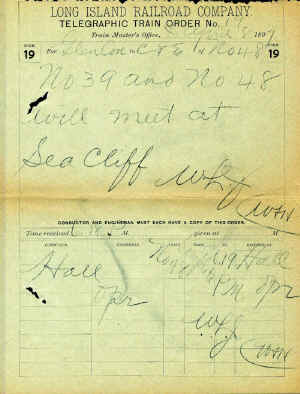 This
Form 19 is similar to the one above, also copied at Nassau, Glen Cove and
dates from April 8, 1897.
This
Form 19 is similar to the one above, also copied at Nassau, Glen Cove and
dates from April 8, 1897. Notice
the shape and format has now changed for the Form 19 orders.
This sample was also issued at "X", the Train Master's
Office at L. I. City and copied at train order office "GV" which
were the telegraphic call letters for Nassau, Glen Cove on June 8, 1898.
The operator's name was Best and the initials of the Super, L.P.P.
represented L. P. Pairo.
Notice
the shape and format has now changed for the Form 19 orders.
This sample was also issued at "X", the Train Master's
Office at L. I. City and copied at train order office "GV" which
were the telegraphic call letters for Nassau, Glen Cove on June 8, 1898.
The operator's name was Best and the initials of the Super, L.P.P.
represented L. P. Pairo.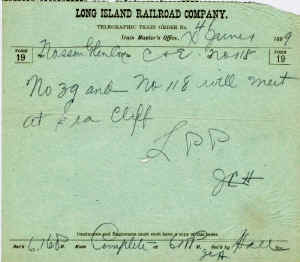 This
Form 19 is similar to the previous one in format.
Also copied at Nassau, Glen Cove, operator Hall indicated the
station name and not the telegraphic calls.
This was common practice up to the end of the 1920s.
This
Form 19 is similar to the previous one in format.
Also copied at Nassau, Glen Cove, operator Hall indicated the
station name and not the telegraphic calls.
This was common practice up to the end of the 1920s.
 The
format has again been changed as we can see on this new Form 19, issued at
"X" (indicated in front of the date at the top) and also copied
by the train order office at L. I. City . . . not to be confused with the
Train Master's office from whence it was issued.
Two different locations. This
order is quite interesting to read the routing of engine #41.
The operator copying the order was named Neesham and the initials
F. H. represented the Super, Frank Hartenstien.
Note that this order was directed to veteran LIRR engineer
Sylvester P. Doxsey whose name appears at the top of the order and who was
operating this light engine.
The
format has again been changed as we can see on this new Form 19, issued at
"X" (indicated in front of the date at the top) and also copied
by the train order office at L. I. City . . . not to be confused with the
Train Master's office from whence it was issued.
Two different locations. This
order is quite interesting to read the routing of engine #41.
The operator copying the order was named Neesham and the initials
F. H. represented the Super, Frank Hartenstien.
Note that this order was directed to veteran LIRR engineer
Sylvester P. Doxsey whose name appears at the top of the order and who was
operating this light engine. This
is an early LIRR clearance card that was issued with Form 19 orders in
1906. It was copied at the
Eastport train order office which was located in the ticket office of the
depot as "PT" cabin at the junction of the Manorville-Eastport
branch had not yet been constructed. The operator appears to be named
Tuttle, an old Long Island name.
This
is an early LIRR clearance card that was issued with Form 19 orders in
1906. It was copied at the
Eastport train order office which was located in the ticket office of the
depot as "PT" cabin at the junction of the Manorville-Eastport
branch had not yet been constructed. The operator appears to be named
Tuttle, an old Long Island name. The
Pennsylvania Railroad took control of the LIRR in 1900 and by 1928, major
changes were set in place, one being the employee timetable copying the
style of the PRR ETTs and the other being the installation of unattended
block office signals along with the institution of the "K"
clearance card block system, which had been developed by and was already
in use on the Pennsy system. The
clearance card in use by the LIRR as depicted several images above was
discontinued and replaced with the Pennsy-style "K"-card however
the Form 19 train orders and the "K" cards still read "Long
Island Railroad" (one word). This
was soon to change. This order
was issued on October 22, 1929 at the Superintendent's Office at Jamaica
(which had replaced the old Trainmaster's Office at L. I. City after the
1913 opening of the new Jamaica complex) and was copied at MT tower in
Mineola by operator Webb with the initials of F. R. G. representing the
Super, Felix R. Gerard. Note
the order is addressed to the C&E (conductor and engineer) of work
extra locomotive #141 and to the C&M (conductor and motorman) of MU
motor #1349 running between MT tower and HC tower at Hempstead Crossing,
Garden City. I know a lot of
LIRR engineers have argued over the years that NONE of the MU engineers
were called motormen . . . a term "relegated" to trolley
operators and elevated/subway train operators however, here's living proof
that LIRR men who operated MU cars during that era WERE referred to as
Motormen.
The
Pennsylvania Railroad took control of the LIRR in 1900 and by 1928, major
changes were set in place, one being the employee timetable copying the
style of the PRR ETTs and the other being the installation of unattended
block office signals along with the institution of the "K"
clearance card block system, which had been developed by and was already
in use on the Pennsy system. The
clearance card in use by the LIRR as depicted several images above was
discontinued and replaced with the Pennsy-style "K"-card however
the Form 19 train orders and the "K" cards still read "Long
Island Railroad" (one word). This
was soon to change. This order
was issued on October 22, 1929 at the Superintendent's Office at Jamaica
(which had replaced the old Trainmaster's Office at L. I. City after the
1913 opening of the new Jamaica complex) and was copied at MT tower in
Mineola by operator Webb with the initials of F. R. G. representing the
Super, Felix R. Gerard. Note
the order is addressed to the C&E (conductor and engineer) of work
extra locomotive #141 and to the C&M (conductor and motorman) of MU
motor #1349 running between MT tower and HC tower at Hempstead Crossing,
Garden City. I know a lot of
LIRR engineers have argued over the years that NONE of the MU engineers
were called motormen . . . a term "relegated" to trolley
operators and elevated/subway train operators however, here's living proof
that LIRR men who operated MU cars during that era WERE referred to as
Motormen. 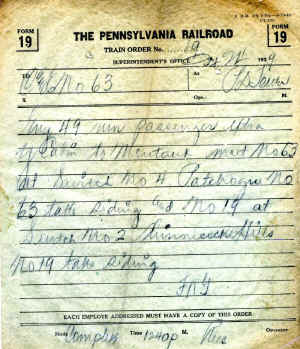 Major
change. . . . this order was copied on October 24, 1929 at "PD"
tower in Patchogue but you'll notice that two days after the issuance of
the previous order depicted above, this Form 19 is now on Pennsylvania
Railroad stationery. Form 19
train orders will remain so, going from green paper to yellow paper up
until 1950 when "Long Island Rail Road" will again be indicated
on the forms. There will be
flimsies as well as carbon-coated-back forms in use during these years.
This order was copied by block operator Rees and again, the initials of F.
R. G. represented Super Felix R. Gerard.
Train #63 to whose crew the order was addressed, was the
Patchogue-Babylon "Scoot". The
block station identified in the order as "Y" was the block
office cabin at the end of double track east of the station in Sayville.
Major
change. . . . this order was copied on October 24, 1929 at "PD"
tower in Patchogue but you'll notice that two days after the issuance of
the previous order depicted above, this Form 19 is now on Pennsylvania
Railroad stationery. Form 19
train orders will remain so, going from green paper to yellow paper up
until 1950 when "Long Island Rail Road" will again be indicated
on the forms. There will be
flimsies as well as carbon-coated-back forms in use during these years.
This order was copied by block operator Rees and again, the initials of F.
R. G. represented Super Felix R. Gerard.
Train #63 to whose crew the order was addressed, was the
Patchogue-Babylon "Scoot". The
block station identified in the order as "Y" was the block
office cabin at the end of double track east of the station in Sayville.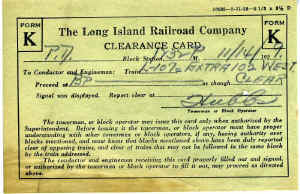 This
is a sample of one of the early PRR-style "K" cards printed with
"Long Island Railroad" (one word) on the form.
It was copied by block operator Ray Hubbs at "PD" tower
in Patchogue on November 14, 1929 and issued to the C&E of H10s
locomotive #102 pulling freight L107 east.
The call letters "BP" represented the unattended block
signal at Bayport.
This
is a sample of one of the early PRR-style "K" cards printed with
"Long Island Railroad" (one word) on the form.
It was copied by block operator Ray Hubbs at "PD" tower
in Patchogue on November 14, 1929 and issued to the C&E of H10s
locomotive #102 pulling freight L107 east.
The call letters "BP" represented the unattended block
signal at Bayport.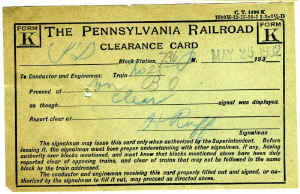 Here's
a "K" card copied at "PD" tower in Patchogue by block
operator H. Ruff, on a Pennsylvania Railroad form on May 25, 1932 and
addressed to train #25. The
call letters of "VN" and "BO" represented the
unattended block signals at Brookhaven and Bellport respectively.
It's 7:36 pm and the 2nd trick operator is on duty at
"PD" but the operators on duty at those stations indicated on
the "K" card were gone for the day as those offices only had 1st
trick operators, so the unattended block signals were in service for all
trains after the offices closed and until the men returned in the morning
to start their 1st trick jobs.
Here's
a "K" card copied at "PD" tower in Patchogue by block
operator H. Ruff, on a Pennsylvania Railroad form on May 25, 1932 and
addressed to train #25. The
call letters of "VN" and "BO" represented the
unattended block signals at Brookhaven and Bellport respectively.
It's 7:36 pm and the 2nd trick operator is on duty at
"PD" but the operators on duty at those stations indicated on
the "K" card were gone for the day as those offices only had 1st
trick operators, so the unattended block signals were in service for all
trains after the offices closed and until the men returned in the morning
to start their 1st trick jobs.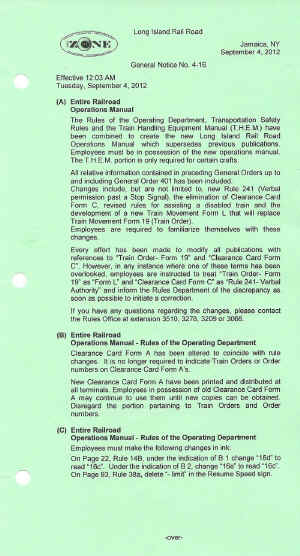 General
Notice GN 4-16 which effectively ends the long use of the Form 19 train
order on the Long Island Rail Road.
General
Notice GN 4-16 which effectively ends the long use of the Form 19 train
order on the Long Island Rail Road. The
front of the new Form "L"
The
front of the new Form "L" 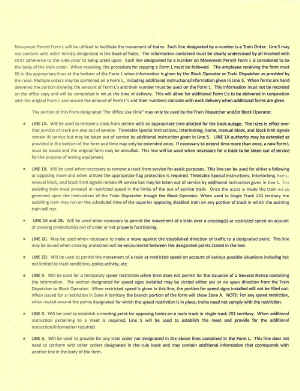 The
back of the new Form "L"
The
back of the new Form "L"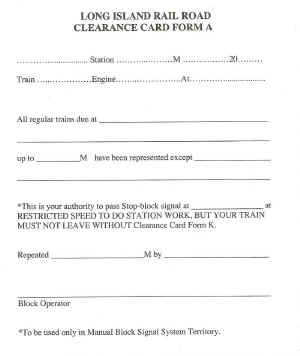 The
new Form A clearance card
The
new Form A clearance card